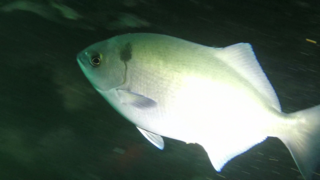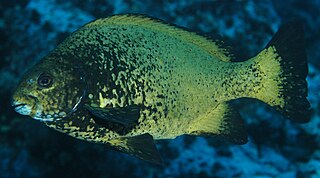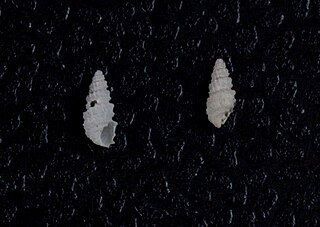
Genus is a taxonomic rank above species and below family as used in the biological classification of living and fossil organisms as well as viruses. In binomial nomenclature, the genus name forms the first part of the binomial species name for each species within the genus.

In taxonomy, binomial nomenclature, also called binary nomenclature, is a formal system of naming species of living things by giving each a name composed of two parts, both of which use Latin grammatical forms, although they can be based on words from other languages. Such a name is called a binomial name, a binomen, binominal name, or a scientific name; more informally it is also historically called a Latin name. In the International Code of Zoological Nomenclature (ICZN), the system is also called binominal nomenclature, with an "n" before the "al" in "binominal", which is not a typographic error, meaning "two-name naming system".

Columbidae is a bird family consisting of doves and pigeons. It is the only family in the order Columbiformes. These are stout-bodied birds with short necks and short slender bills that in some species feature fleshy ceres. They primarily feed on plants, and can be taxonomically divided amongst granivores, that feed mostly on the ground on seeds, and frugivores, that feed mostly on fruits, from branches. The family occurs worldwide, often in close proximity with humans, but the greatest variety is in the Indomalayan and Australasian realms.

Herons are long-legged, long-necked, freshwater and coastal birds in the family Ardeidae, with 74 recognised species, some of which are referred to as egrets or bitterns rather than herons. Members of the genus Botaurus are referred to as bitterns, and, together with the zigzag heron, or zigzag bittern, in the monotypic genus Zebrilus, form a monophyletic group within the Ardeidae. Egrets do not form a biologically distinct group from herons, and tend to be named differently because they are mainly white or have decorative plumes in breeding plumage. Herons, by evolutionary adaptation, have long beaks.

The Lacertidae are the family of the wall lizards, true lizards, or sometimes simply lacertas, which are native to Afro-Eurasia. It is a diverse family with at about 360 species in 39 genera. They represent the dominant group of reptiles found in Europe.
In biology, a monotypic taxon is a taxonomic group (taxon) that contains only one immediately subordinate taxon. A monotypic species is one that does not include subspecies or smaller, infraspecific taxa. In the case of genera, the term "unispecific" or "monospecific" is sometimes preferred. In botanical nomenclature, a monotypic genus is a genus in the special case where a genus and a single species are simultaneously described.

In zoological nomenclature, a type species is the species name with which the name of a genus or subgenus is considered to be permanently taxonomically associated, i.e., the species that contains the biological type specimen. A similar concept is used for suprageneric groups and called a type genus.

Rancagua is a city and commune in central Chile and part of the Rancagua conurbation. It is the capital of the Cachapoal Province and of the O'Higgins Region, located 87 km (54 mi) south of the national capital of Santiago.

The halfmoon, also known as the blue perch, is a species of marine ray-finned fish, a sea chub from the subfamily Scorpidinae, part of the family Kyphosidae. It is native to the coasts of the eastern Pacific Ocean off western North America. It is fished for using hook and line and it is a desirable food fish.

The sea chubs, also known as rudderfish and pilot fish and in Hawaiian as enenue or nenue, are a family, Kyphosidae, of fishes in the order Perciformes native to the Atlantic, Indian and Pacific Oceans usually close to shore in marine waters.

Rodeo is a traditional equestrian sport in Chile, declared the national sport in 1962.
A medialuna is a crescent-shaped corral used for rodeos, the official sport in Chile. They are generally 64 to 66 metres in diameter. Chilean rodeos are not quite the same sport famous in the American West; they involve two riders on horseback trying to herd a calf around a circular arena, attempting to pin him against several large cushions.

Chrysallida is a speciose genus of minute sea snails, pyramidellid gastropod mollusks or micromollusks in the family Pyramidellidae within the tribe Chrysallidini.

The Scorpidinae, commonly known as halfmoons, knifefishes, and sweeps, are a subfamily of the family Kyphosidae, the sea chubs, a family of marine fish in the order Perciformes. The Scorpidinae are distributed throughout the Pacific and east Indian Oceans, with species occurring in the waters of North America, South America, Asia, Australia, and numerous islands. Most inhabit the continental shelf in shallow rock and kelp reefs and deeper offshore reefs, whilst others are found well offshore in a pelagic setting. Most of the Scorpidinae are carnivorous, taking a variety of small crustaceans, although some are partly herbivorous. A number of the larger species are fished commercially and recreationally, and are considered good table fish.
M. californiensis may refer to:
Chrysallida medialuna is a species of sea snail, a marine gastropod mollusk in the family Pyramidellidae, the pyrams and their allies. The species is one of a number within the genus Chrysallida.

Graus nigra is a species of ray-finned fish endemic to the Pacific coast of South America, ranging from Valdivia in Chile to southern Peru. This species grows to a total length of 64.6 cm (25.4 in) and is popular as a game fish. This species is the only known member of its genus, and is known locally as vieja negra.

The Solanaceae, or the nightshades, is a family of flowering plants that ranges from annual and perennial herbs to vines, lianas, epiphytes, shrubs, and trees, and includes a number of agricultural crops, medicinal plants, spices, weeds, and ornamentals. Many members of the family contain potent alkaloids, and some are highly toxic, but many—including tomatoes, potatoes, eggplant, bell, and chili peppers—are used as food. The family belongs to the order Solanales, in the asterid group and class Magnoliopsida (dicotyledons). The Solanaceae consists of about 98 genera and some 2,700 species, with a great diversity of habitats, morphology and ecology.
Blue perch can refer to several species of fish:
Medialuna ancietae is a species of sea chub native to the Pacific coast of South America where it inhabits the giant kelp forests. It is known locally as acha, mero del sur or chino.














